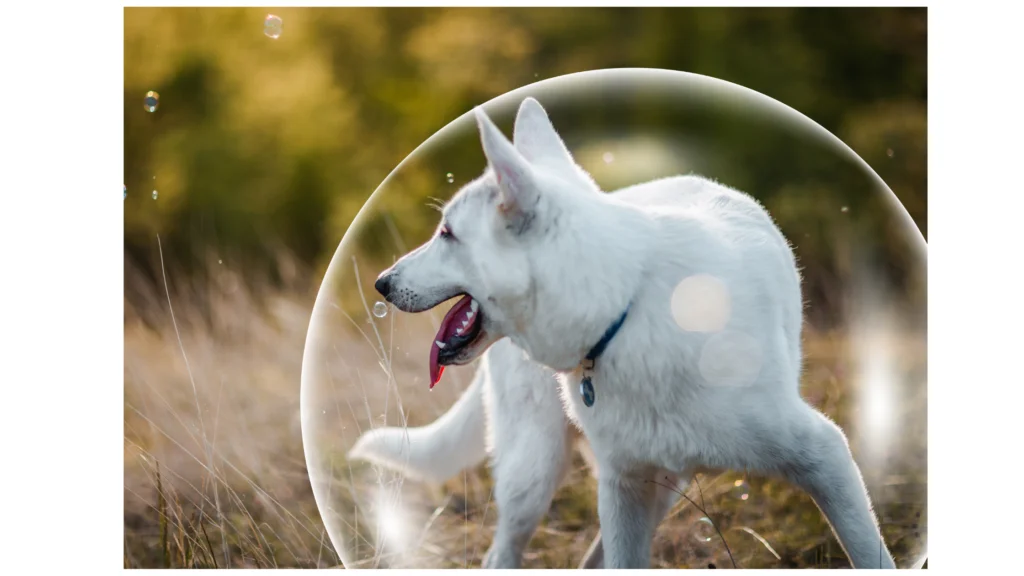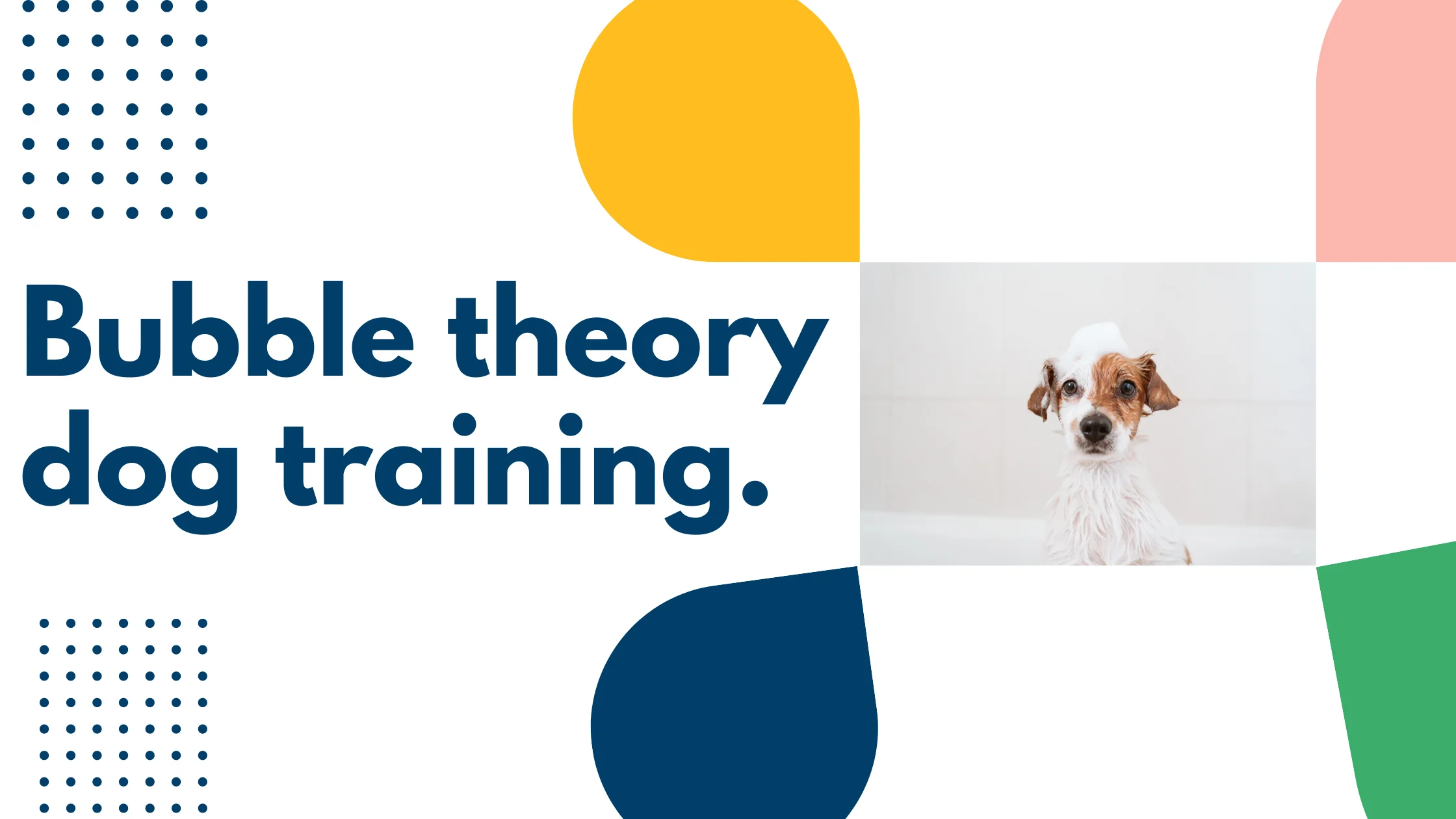We’re always looking for new and effective methods when training our furry friends. One such method that has gained popularity recently is the “Bubble Theory dog training”.
This approach centers around creating a “bubble” of safety and trust around your dog to encourage good behavior.
In this article, we will delve into the effectiveness of this method, its benefits, drawbacks, and how you can use it to train your dog.
What is the Bubble Theory Dog Training?

The bubble theory dog training method is an approach that aims to establish a close bond and effective communication between a dog and its owner.
It is based on the idea that dogs have a “bubble” or personal space that they are protective of and that owners need to understand and respect.
This method prioritizes positive reinforcement and rewards over punishment and correction, and it can be used to train dogs of all ages and breeds.
This article will explore the principles of the bubble theory dog training method and its advantages and disadvantages. We will also provide some tips on how to apply this approach to train your furry friend.
The Science Behind the Bubble Theory: How Does It Work?
The Bubble Theory dog training method is based on creating a safe and positive environment for your dog. It focuses on the “bubble,” representing the dog’s personal space or comfort zone. The idea is to create a bubble around your dog to protect them from external stressors, distractions, and negative experiences.
The bubble is created using positive reinforcement techniques such as treats, toys, and praise to build trust and reinforce good behavior. By creating a positive bubble around your dog, you are helping them feel safe and secure, which in turn helps them learn and retain new behaviors more effectively.
The theory is based on the idea that dogs learn best in a stress-free environment and that by creating a positive bubble, we can reduce stress and increase learning opportunities. It also emphasizes the importance of setting realistic training goals, understanding your dog’s needs and personality, and being patient and consistent in your training approach.
Overall, the Bubble Theory is a gentle and effective training method that prioritizes your dog’s emotional well-being. Building a positive bubble around your dog can create a strong foundation for learning and behavior modification.
Bubble theory dog training for reactive and fearful dogs.

For reactive and fearful dogs, the safety bubble is crucial. Due to their need to feel safe, their bubble is larger, sometimes much larger than confident dogs.
A dog’s behavior will change when his safe space is threatened, so it’s critical to observe carefully.
- In this case, he might focus on the thing that is heading for the outer edge of his bubble.
- There is a good chance he will lick his lips and he will certainly feel tense.
Keep an eye out for those changes. Your dog’s bubble needs to be protected when changes occur. It won’t take long for your dog’s body to produce stress hormones if you don’t take a break.
Also Read: How to Stop Dog Nipping when Excited – All Regarding Dogs
Benefits of the Bubble Theory Method for Your Dog

The Bubble Theory method of dog training benefits dogs and their owners. One of the biggest advantages is that it promotes a positive relationship between the dog and the owner. When you use the Bubble Theory method, your dog will learn to trust and respect you as a leader. This leads to a stronger bond and makes training more effective.
Another benefit of this training method is that it is based on the dog’s instincts. By using positive reinforcement and encouraging good behavior, you work with your dog’s instincts instead of against them. This helps to create a more harmonious relationship and reduces the risk of behavior problems.
Creating a safe and positive training environment can help your dog feel more relaxed and confident. Additionally, the Bubble Theory method is gentle and non-threatening. This is particularly beneficial for dogs that are anxious or fearful.
The Bubble Theory method is a great way to train your dog positively and effectively. It helps to create a strong bond between you and your pet, encourages good behavior, and is gentle and non-threatening.
Drawbacks of the Bubble Theory Method for Your Dog
While the Bubble Theory method has advantages, it has some potential drawbacks. One potential issue is that it requires a lot of time and patience from the owner, as it can take some dogs a while to understand and respect the bubble fully. Additionally, some dogs may respond poorly to the method if they are naturally more independent or assertive. They may see the owner’s attempts to control their space challenging their authority.
Another potential drawback is that the bubble can become a crutch, and owners may rely too heavily on the technique instead of building a more well-rounded training plan for their dog. Over-reliance on any single training method can limit a dog’s development and prevent them from reaching its full potential.
Lastly, some experts have expressed concern that the Bubble Theory method could lead to anxiety or aggression in dogs, as it could potentially reinforce feelings of isolation or fear in dogs already prone to these issues. It is important to carefully evaluate your dog’s temperament and consult a professional trainer before implementing any new training technique.
How to Use the Bubble Theory Method to Train Your Dog
The bubble theory method is a unique approach to dog training that requires a certain level of commitment and patience from the owner. Here are some steps to get started with using the bubble theory method to train your dog:
- Establish the bubble: The first step is establishing your dog’s bubble or personal space. This involves creating a boundary around your dog where they feel comfortable and safe. It’s important to respect this boundary and not push your dog outside.
- Use positive reinforcement: The bubble theory method relies heavily on positive reinforcement. This means rewarding your dog for good behavior and ignoring bad behavior. Rewards can include treats, toys, and praise.
- Be consistent: Consistency is key when training your dog using the bubble theory method. Ensure everyone in the household is on board with the same training techniques and rules.
- Avoid punishment: Punishing your dog for bad behavior goes against the principles of the bubble theory method. Instead, ignore the bad behavior and redirect your dog’s attention to something positive.
- Practice patience: Training your dog using the bubble theory method takes time and patience. Stay calm if your dog catches on right away. Keep practicing and rewarding good behavior.
- Seek professional help: If you’re having difficulty training your dog using the bubble theory method, consider seeking the help of a professional dog trainer who is familiar with this method.
Following these steps and consistently using the bubble theory method can train your dog to be well-behaved and happy.
Tips and Tricks for Successful Bubble Theory Training
Bubble Theory dog training is an effective and positive way to train your dog, but like any training method, it requires patience, consistency, and some tips and tricks to make it successful. Here are some helpful suggestions for using the Bubble Theory method to train your dog:
- Start Slowly: When introducing your dog to the Bubble Theory method, it’s important to start slowly and not overwhelm them with too much stimulation or interaction. Begin by simply creating a physical boundary around your dog and gradually increasing the distraction and stimulation level over time.
- Use Positive Reinforcement: Positive reinforcement is key to the Bubble Theory method. Always reward your dog with treats, praise, and attention when they are inside the bubble and following your commands. This will encourage them to continue behaving positively.
- Be Consistent: Consistency is essential for any training method to be effective, and the Bubble Theory is no exception. Use the same commands, gestures, and boundaries each time you train your dog, and ensure that everyone in your household uses the same approach.
- Keep Training Sessions Short: Dogs have a limited attention span, so keep your training sessions short and focused. This will help your dog stay engaged and motivated.
- Be Patient: Training your dog with the Bubble Theory method takes time and patience. It’s important to stay calm and relaxed if your dog responds quickly. Keep practicing and reinforcing positive behaviors; eventually, your dog will understand what is expected of them.
Following these tips and tricks, you can effectively train your dog using the Bubble Theory method and create a positive and happy relationship with your furry friend.
Common Misconceptions about the Bubble Theory Method
The bubble theory method is a relatively new and lesser-known dog training approach often misunderstood by those who need to become more familiar with it. Here are some common misconceptions about the bubble theory method and why they are not accurate:
- It Is Only for Aggressive Dogs: One of the most common misconceptions about the bubble theory method is that it is only suitable for aggressive dogs. However, the bubble theory method can be used for any dog, regardless of temperament or behavior.
- It Is Cruel: Some people believe that the bubble theory method is cruel because it involves keeping the dog on a short leash and not allowing them to interact with other dogs or people. However, this is different. The bubble theory method is a positive reinforcement technique that encourages good behavior and discourages negative behavior.
- It Requires Isolation: Another common misconception about the bubble theory method is that it requires isolating the dog from the world. However, this is not true. The bubble theory method involves gradually expanding the dog’s social circle over time and allowing them to interact with more people and dogs as they become more comfortable.
- It Is Ineffective: Some people believe the bubble theory method is less effective than other dog training methods. However, this is only sometimes true. While the bubble theory method may not work for every dog, it can be highly effective for many dogs, particularly those who have experienced trauma or have behavioral issues.
The bubble theory method is a unique and effective dog training approach that can benefit many dogs and their owners. As with any dog training method, it is important to approach it with an open mind and a willingness to learn and adapt to your dog’s needs.
Alternatives to the Bubble Theory Method
While the Bubble Theory method can be effective for some dogs and their owners, it may only work for some. If you are interested in alternative training methods, consider some of the following:
- Positive Reinforcement Training: This popular training method uses rewards such as treats, toys, and praise to encourage good behavior in dogs. This approach is often recommended for puppies and dogs with less severe behavioral issues.
- Clicker Training: This training method uses a small handheld device that makes a clicking sound when pressed. The click is paired with a treat or reward to reinforce positive behavior.
- Behavior Modification: This approach addresses and modifies specific behaviors causing problems. This method may involve desensitization and counter-conditioning to help dogs overcome fears and phobias.
- Professional Training: If you are struggling to train your dog on your own, consider enlisting the help of a professional dog trainer. A trainer can assess your dog’s behavior and develop a customized training plan to help address specific issues.
Remember, every dog is unique, and what works for one may not work for another. It’s essential to find a training method that works for you and your dog and be patient and consistent in your training efforts.
Is the Bubble Theory Method Right for Your Dog?
The bubble theory method is more than a one-size-fits-all solution for dog training. While it can be effective for some dogs, there may be better approaches for others. When deciding if the bubble theory method is right for your dog, consider your dog’s personality, behavior, and learning style.
Dogs who are shy or anxious may benefit from the protective bubble that the method provides, while dogs who are more outgoing or assertive may find the method frustrating or limiting. Additionally, some dogs may respond better to other training methods focusing on positive reinforcement and reward-based training.
Before starting any training program, it’s important to consult with a professional dog trainer or behaviorist to determine the best approach for your specific dog. They can help you assess your dog’s needs and create a customized training plan that addresses its unique challenges and goals.
Ultimately, the decision to use the bubble theory method should be based on your dog’s needs and personal preferences as a trainer. With the right guidance and commitment, this method can be a valuable tool in helping your dog become a well-behaved and happy companion.
Conclusion: Incorporating the Bubble Theory Method into Your Dog’s Training
The Bubble Theory method is a unique approach to dog training that can be highly effective when used correctly. By using positive reinforcement and gradual exposure to new environments and situations, dogs can learn to feel comfortable and confident in various settings. However, it’s important to recognize that this method may only fit some dogs or owners.
Before deciding to incorporate the Bubble Theory method into your dog’s training, carefully consider your dog’s personality and individual needs. Also, please consult a professional dog trainer with experience using this method to ensure you use it correctly and effectively.
When used correctly, the Bubble Theory method can help you build a strong bond with your dog and set them up for success in various situations. With patience, consistency, and a willingness to adapt to your dog’s unique needs, you can help your furry friend develop into a happy and confident companion.
Hope you find this information helpful. Thanks for reading.
